UK To Remove Andrew From Role As Royal Navy Vice Admiral
LONDON, Nov 2 (Reuters) – Britain’s former prince Andrew is due to be stripped of his last remaining military position as part of King Charles’ decision to remove his brother from public...
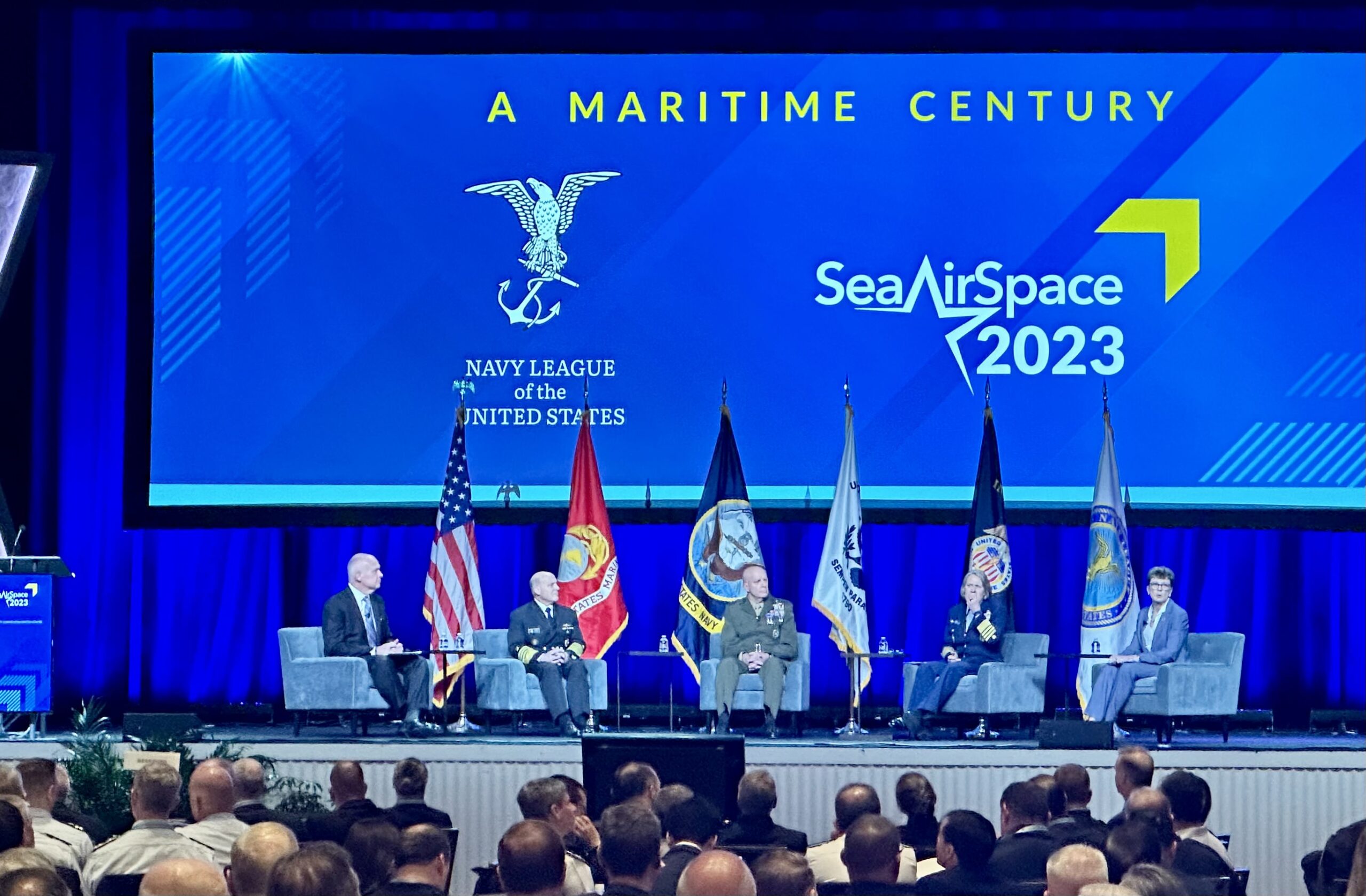
by Captain John Konrad (gCaptain) The brewing conflict between the US Navy and the US Marine Corps over the production of amphibious warships is reaching a critical level of concern. At the Navy League Sea Air Space Conference in Maryland, Marine Corps generals, led by Commandant David Berger, are passionately pushing for the construction of more ships, while the Navy is planning to halt production and initiate a “strategic shipbuilding pause” to assess future amphibious vessels. This stands in stark contrast to US Coast Guard Commandant Linda Fagan – her service is in a fight with the Navy to build icebreakers – and Merchant Marine Commandant Ann Phillips – who needs Chief Of Naval Operations Admiral Mike Gilday’s support for the Tanker Security Program – are notably silent on the issue.
The silence of two commandants and the growing rift with the third is alarming and could lead to devastating consequences for our national security and military readiness as tensions rise with two adversarial seapowers: Russia and China.
According to Defense News the Marine Corps has requested $1.71 billion to complete the next San Antonio-class ship, LPD-33, as part of its fiscal 2024 unfunded priorities list. The San Antonio-class amphibious transport dock is designed to support and transport US Marine Corps troops, vehicles, and equipment for amphibious missions. These missions often involve moving troops from ship to shore for combat or humanitarian operations. San Antonio-class ships are crucial for the US Navy and Marine Corps to project power and respond to global crises.
The strategic pause and an announcement to decommission additional amphibious ships leaves the Marine Corps below the minimum legal requirement of 31 amphibious ships.
“The amphibious fleet is precisely the right tool to deter our competitors,” General Berger has noted repeatedly.
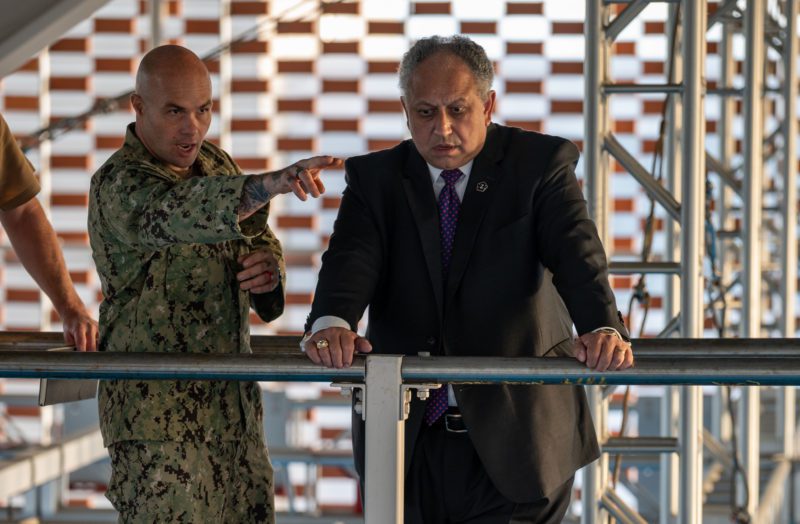
All three services require naval assistance, not only because the Navy collaborates with the US Coast Guard (USCG) on icebreakers, the Marine Corps on amphibious ships, and the US Merchant Marine on sealift tankers, but also because Congress altered the Navy’s legal mission last year. The focus shifted from warfighting to also supporting peacetime missions. The peacetime roles of icebreakers and tankers are evident, but it is also essential to highlight that Marine Corps ships play a crucial part in humanitarian operations, such as hurricane relief efforts.
National Defense Magazine writes the 2023 NDAA “changed the mission of the Navy,” FerryBridge Group managing director Bryan McGrath said during a panel discussion at the Navy League’s Sea-Air-Space exposition. “It made the peacetime security and prosperity and the protection thereof co-equal to combat operations at sea.”
“31 amphibs are not enough,” McGrath said. “The mission change made peacetime security and prosperity and the protection they’re co equal to combat operations and see if you think the 31 Amphib decision was done with that mission in mind you are wrong.”
Retired Navy Captain and naval scholar Jerry Hendrix, who recently authored the widely shared article titled The Age of American Naval Dominance Is Over, for the Atlantic concurred and said “Clearly there’s a debate going on between Office of the Secretary of Defense (OSD) with the Navy and Marine Corps on both sides. A number of other large and midsize advocates LVDS and OHS always seem to think that we need a lot less.”

Obtaining direct funding from Congress is essential for the Marine Corps to build ships because, without direct funding, they must request that the Navy includes shipbuilding in its budget. However, the Navy faces significant budget constraints as it shares the total Department of Defense (DoD) budget equally with the Army and Air Force. Ships are generally more expensive than tanks, and the Navy must prioritize its own shipbuilding plans particularly with the military’s increased focus on the Pacific ocean region.
Now that the land war in Afghanistan is over and tensions between China and the island nation of Taiwan heat up the Navy could potentially ask military leaders to appropriate money from the Army budget to shipbuilding, this is a politically dangerous move, especially considering that both the Chairman of the Joint Chiefs of Staff, General Mark A. Milley, and the Secretary of Defense, Lloyd Austin, are Army generals.
The tendency of the Army, Navy, and Marine Corps to fight over the shared DoD budget is one of the reasons why the Secretary of Defense, who holds significant control over budget approval through the office of OSD, is not allowed to serve for seven years after retiring from uniform. However, Congress approved a waiver for General Austin, as they did for Marine General Mattis under Trump, after only three years.
Although Austin has not publicly dismissed shipbuilding efforts, during testimony last week several members of the Senate and Congress have questioned him about shipbuilding and sealift, and he has either avoided or passed every question about ships to someone else. It is challenging to determine whether the Marine Corps’ rift with the Navy is due to Navy leaders blocking amphibious shipbuilding or if Admirals are only following orders from Austin’s OSD.
Either way, critical plans to build the ships that all three Commandants advocated for in this year’s budget fall far short of requirements to move troops, break ice, and deliver fuel via tankers. The situation is concerning and could have significant consequences for our national security and military readiness.
Given that the Marine Corps is part of the Navy and falls under the Navy’s civilian leadership, USMC Commandant Berger cannot openly dispute the Secretary of the Navy’s call for a “strategic pause” in building new amphibious warships. This pause would freeze the construction of new vessels until 2027 and retire several amphibious vessels from service early.
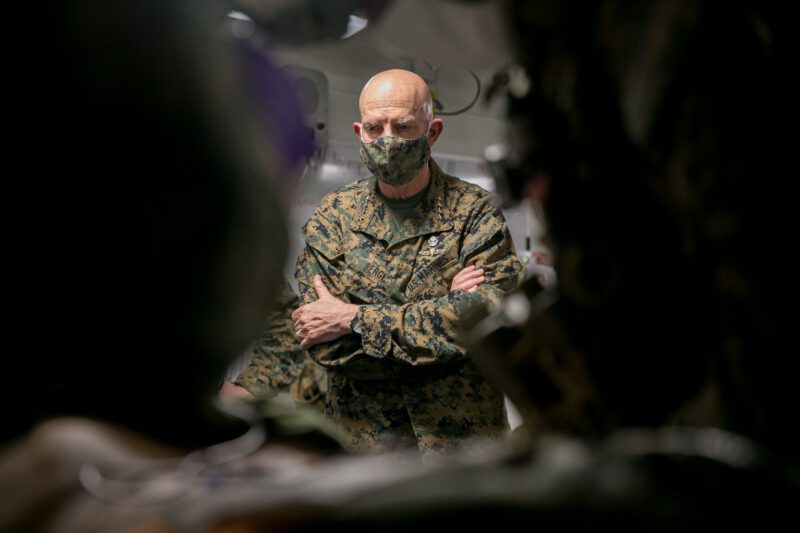
Berger can, however, create public affairs material to demonstrate the importance of these ships to the American public, in hopes that citizens will contact Congress and request direct funding.
This conflict between four military branches has captured the attention of the American Congress, who peppered military leaders with shipbuilding questions last month, has lead to the production of a new USMC YouTube video to capitalize on congressional concern and “sell” the amphibious project to the public. The video aims to showcase the significance of amphibious warships and persuade the public to call Congress and ask representatives to support the continuation of the project.
The ongoing discord between the US Navy and the US Marine Corps is rooted in conflicting views regarding the production line and cost efficiency. While Chief of Naval Operations Adm. Mike Gilday argues that the production line is lagging and anticipates the cost of LPD-32 to increase by up to 25% compared to previous vessels, Commandant of the Marine Corps Gen. David Berger maintains that the production line is operating at peak efficiency, and the shipyard maintains a favorable cost curve in constant-year dollars. Gen. Berger suggests that implementing multiyear procurement contracts, similar to those used for other Navy ship programs, could alleviate some inflationary pressure.
As the dispute continues, the outcome of the new YouTube video and the Marine Corps’ efforts to influence public opinion and persuade lawmakers to support the continuation of the amphibious warship project remains uncertain.
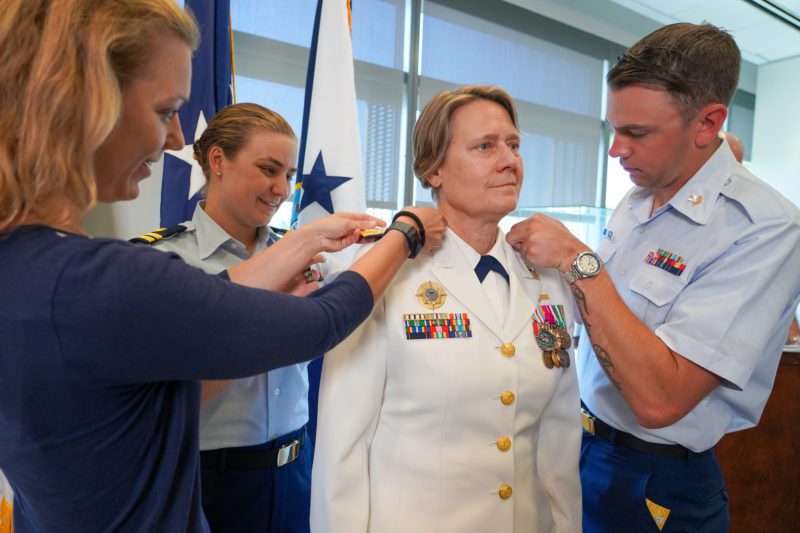
While Berger has been vocal about the need for stronger shipbuilding funding, other Commandants at the conference have remained largely silent. US Coast Guard Commandant Linda Fagan did not question the Navy CNO’s recent disavowal of the partnership between the two services to build critical icebreakers.
Commandant Phillips departed the conference on the first day without delivering a speech. In previous Air Sea Space events, the USCG Commandant would answer questions, but Fagan modified the format of the Commandant’s breakfast on Wednesday to pose questions to a panel instead. Generally, all service chiefs invite the media for discussions, but this year, Navy CNO Gilday was the only chief to extend an invitation to gCaptain for a private meeting.
During the meeting with gCaptain reporters, both Gilday and Secretary of the Navy Del Toro expressed their strong support for the needs of the other sea services.
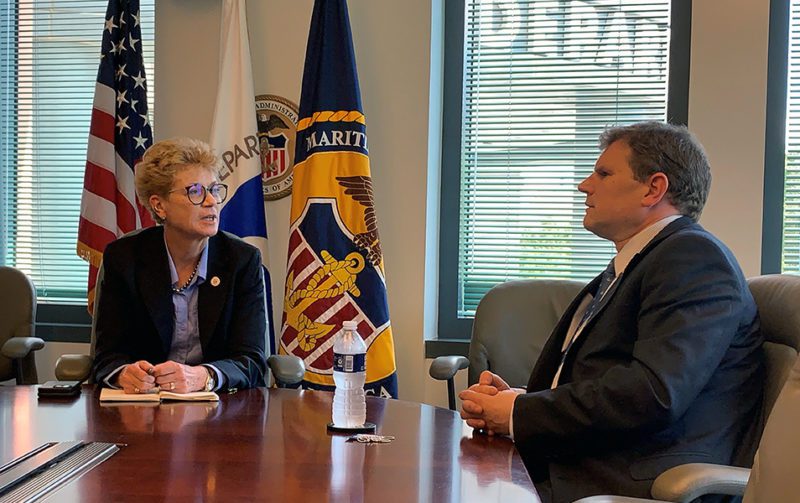
The service chief who should be most concerned about the Navy’s modest shipbuilding plan, US Merchant Service Commandant Ann Phillips, has not been as vocal against the Navy’s shipbuilding policy as the Marine Corps. The plan falls 100 oil tankers short of the minimum required to supply aviators, sailors, and troops in the Pacific with jet fuel. Commandant Phillips has done little to challenge the Navy to build new tankers and oilers or demand that Congress funds them outside the military budget. Neither she nor her boss, Secretary Pete Buttigieg – both US Navy veterans – have challenged the Navy regarding shipbuilding shortfalls. Additionally, Secretary of the Navy Carlos Del Toro has not challenged Buttigieg for not significantly increasing Title XI shipbuild subsidies that he is responsible for funding under his transportation budget. Without those DOT funds – required to offset Chinese manipulation of the shipbuilding market and account for supply chain disruptions – increasing to meet inflation, it’s hard to see how military ship prices can possibly be contained.
It was difficult to assess the extent of the rift because not many at the conference understand Commandant Phillips’ critical role in funding shipyards to invest in the people and technology necessary to drive drive down amphibious ship construction costs. Notably absent from the event (apart from gCaptain) was the leading commercial shipping/shipbuilding media outlets like Tradewinds News or Freightwaves and shipbuilding influencers like Sal Mercogliano (who typically leads a panel). Without this impartial expertise and exposure few had the knowledge needed to ask questions about the common budgetary denominators between all four services. gCaptain was also not invited to talk and questions and our questions we often cut short. In one panel we asked the following question:
Bryan McGrath pointed to a problem that nobody else at this conference would: OSD
Jerry Hendrix’s brilliant Atlantic article dictates both sides of Mahan’s influence of seapower
Naval and Commercial
I want to ask about the prerequisite for both: Influence. How Does OSD influence seapower?
Our largest shipbuilder has a market cap of $8B, VT Halter – builder of our polar security cutter – $15M. Our two largest chip manufacturers NVIDIA and Apple have a $690B, and 2.6T market cap but they got $280B in the chips act. That’s 20 supercarriers or 86 large amphibious ships (LHDs).
We need a ships act but the is navy is the customer NOT the administrator of shipyards that is Secretary Pete.
In 48 hours cabinet members gave Silicon Valley Bank a $25B emergency funding that’s equivolent to 7 LHDs.
$25B in emergency shipyard funds is pocket change in comparison and Secretary Pete Buttigieg has the the power to ask congress for that. Pete had the political influence to push $1.3 trillion infrastructure to his department. We have the most powerful party influencer in recent memory. Secretary Pete is highly popular with democratic voters and is leading Biden by two points in party polls.
And he is a navy vet. He knows the problem and he – not the navy – is authorized to fund shipbuilding via TitleX. And not just shipyards, but he can straight up ask congress to buy floating drydocks, shipyard cranes and submarine tenders for the Department of Transportation ready reserve fleet.
But he is not at this conference. Why? Did he turn down the invitation or has the US Navy not asked him for assistance?
gCaptain reporters were cut short when Secretary Pete’s name was mentioned and the moderator gave panelists no time to answer.
Author’s Note: We want to clarify that the panelist has since apologized, and we do not believe that any ill-intent was present. We appreciate the Navy League’s efforts to include Merchant Marine voices, and we acknowledge that some misunderstandings arose due to our unfamiliarity with military events. Given the military’s lack of institutional knowledge of commercial shipping due to a prolonged ground war on terror, it can be challenging to phrase Merchant Marine questions in a condensed, military acceptable format. However, we have spoken with event sponsors and Navy leaders who are actively working to reestablish ties, and we remain optimistic about continued progress.
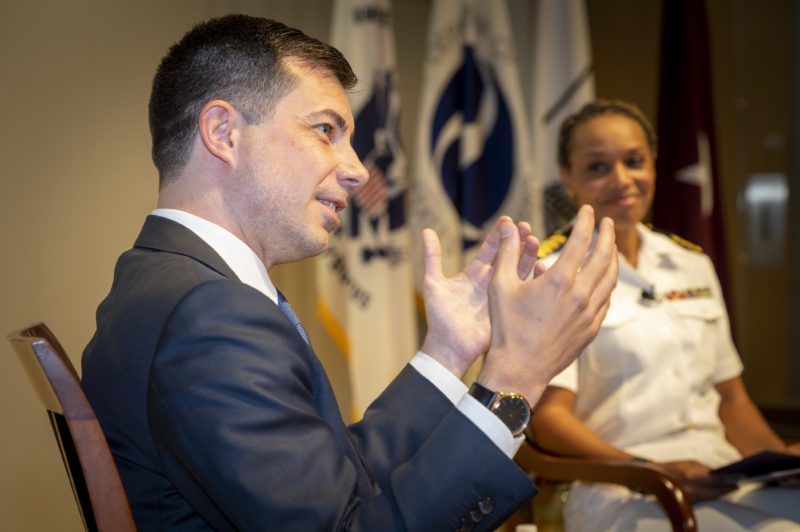
It appears that within the Biden Administration, cabinet members Buttigieg, Austin, and Del Toro (as well as Secretary of Homeland Security Alejandro N. Mayorkas who oversees the US Coast Guard) are hesitant to rock the boat or work together to get the ships that military leaders urgently need. Although the USMC’s YouTube video appealing directly to the public is a positive move that might solve the problem if the other Commandants follow suit, it may not sufficiently convey the urgency of the situation.
Addressing the need for adequate ship purchasing and shipyard funding budgets, as well as fulfilling the Navy’s new peacetime mission and maintaining wartime preparedness, requires key decision-makers to come together. Secretary Austin, in charge of approving final ship purchasing budgets, Secretary Buttigieg, responsible for shipyard funding budgets, and Secretary Mayorkas, the nation’s shipbuilding regulator, should collaborate with all three Commandants and present a united front to the Senate.
This effort might also require the participation of a senior White House official and the Office of Management and Budget Director, Shalanda Young. A former Commandant who spoke to gCaptain stated that Young’s office has throttled down shipbuilding budgets across the Department of Defense, Department of Homeland Security, and Department of Transportation. By joining forces, these officials can more effectively advocate for the funding necessary to achieve their objectives.
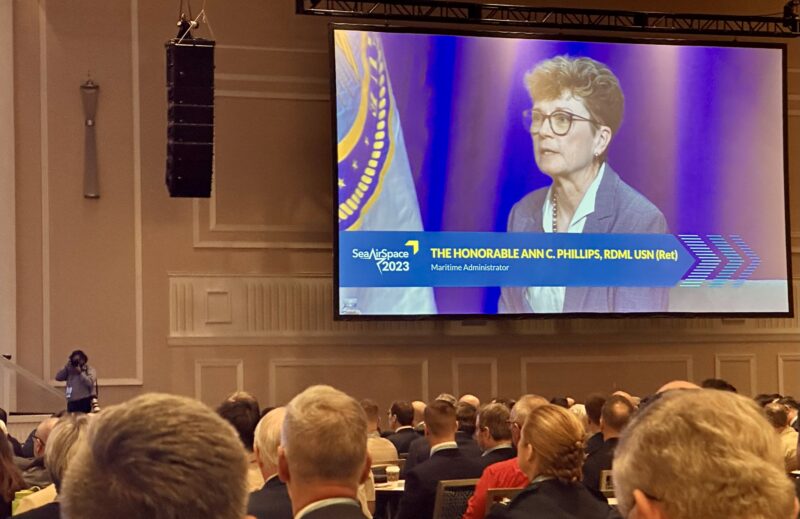
It is both unfair and detrimental to national security to place the burden of difficult decisions on the shoulders of the Chief of Naval Operations, Mike Gilday, especially when cabinet leaders are not working together to develop joint solutions with Congress. If there is one failure attributable to Gilday it is this: he is the military’s strongest advocate for Joint Cooperation with allies but has failed to ally the cooperation of the Cabinet secretaries.
Lastly, it is important to note that while Democratic party members were mentioned in this article, both Democrat and Republican leaders have contributed to this crisis over decades. Those interested in understanding more about the policy failures leading up to this crisis are encouraged to read the following two books:
The Abandoned Ocean: A History of United States Maritime Policy
Brute: The Life of Victor Krulak, U.S. Marine
USCG Navy Shipbuilding Clash: Top Navy Admiral Says No To Icebreakers
US Merchant Marine Navy Shipbuilding Clash: The US Navy Needs Tankers: A Crisis In Capability

Sign up for gCaptain’s newsletter and never miss an update

Subscribe to gCaptain Daily and stay informed with the latest global maritime and offshore news
Essential news coupled with the finest maritime content sourced from across the globe.
Sign Up